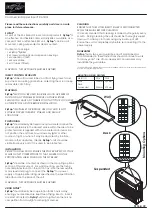
DEFINITION OF TERMS (Continued)
Bursting Disc: A disc installed in the tank adaptor which min-
imizes the remote chance of siphoning of the agent into the
discharge piping during extreme temperature variations.
Cartridge: A hermetically sealed, steel pressure vessel con-
taining nitrogen or carbon dioxide gas used to pressurize the
agent tank.
Cooking Appliance: Includes, but is not limited to, fryers, grid-
dles, ranges, upright broilers, chain broilers, natural charcoal
broilers, or char-broilers (electric, lava rock, gas-radiant, or
mesquite).
Cooking Area: Cooking area is defined as the maximum
surface that requires protection. Each type of appliance has a
defined cooking area with parameters that vary for each appli-
ance. For example, the cooking area for a griddle is the entire
flat cooking surface, while a fryer may have two areas that need
consideration, depending on whether the fryer has a dripboard
or not.
Conduit Offset Assembly: A pre-formed piece of conduit which
can be installed between the ANSUL regulated release and the
conduit to allow the wire rope for the detection, gas valve and
remote manual pull station to be installed in a more convenient
manner.
Depth: When referring to depth as a linear dimension, it is the
horizontal dimension measured from front to back of the appli-
ance or plenum.
Detector: A device which includes the detector bracket, detector
linkage, and fusible link used for automatic operation of the fire
suppression system.
Detector Linkage: A device used to support the fusible link.
Discharge Hose Assembly: An agent distribution hose to be
used with castered cooking appliances with castered supports
to allow the movement of the appliance for service or cleaning
purposes.
Distribution Piping: Piping which delivers the extinguishing
agent from the tank to each discharge nozzle. See also Supply
or Branch lines.
Ducts (or Duct System): A continuous passageway for the
transmission of air and vapors which, in addition to the contain-
ment components themselves, may include duct fittings, damp-
ers, duct filters, duct transitions, in-line or end-duct pollution con-
trol units (PCUs), and/or other items or air handling equipment.
Electrostatic Precipitator: A device used to aid in the cleaning
of the exhaust air. This device is normally installed at or near the
base of the ventilation duct or may be included as an integral
part of a pollution control unit (PCU).
Expellant Gas Line: Piping and/or hose which supplies the
nitrogen or carbon dioxide gas from the regulated release
assembly/regulated actuator assembly to each agent tank.
Flexible Conduit: A flexible means to route stainless steel cable
from the AUTOMAN Regulated Release to a manual pull station
or mechanical gas valve.
Flow Number: Term used in system design to describe the flow
capacity of each nozzle used to determine the quantity of tanks
needed to cover a certain group of hazards.
Fusible Links: A fixed temperature heat detecting device
employed to restrain the operation of a mechanical control until
its designed temperature is reached, allowing separation of the
link and system operation.
Gas Valve: An electrically or mechanically operated device
used to shut off the gas supply to the cooking equipment when
the system is actuated.
Gas Valve Air Cylinder: An air cylinder, located in the release
mechanism, which operates pneumatically to mechanically
unlatch a mechanical gas valve actuator, causing the gas valve
to close upon system actuation.
High Proximity: Indicates a distance (vertically) between the
nozzle tip and the surface of the appliance being protected.
Hood: A device provided for cooking appliances to direct and
capture grease-laden vapors and exhaust gases from cooking
appliances. It shall be constructed in a manner which meets the
requirements of NFPA 96.
Liquid Agent: A potassium-based solution used for the knock-
down and suppression of fire.
Low Proximity: Indicates a distance (vertically) between the
nozzle tip and the surface of the appliance being protected.
Maximum Length of Cooking Appliance: The maximum
dimension, on any side, which may be protected by one nozzle.
Maximum Piping: Specified length of piping and number of
fittings which must not be exceeded for each system.
Medium Proximity: Indicates a distance (vertically) between
the nozzle tip and the surface of the appliance being protected.
Minimum Piping: Minimum length of distribution piping required
between the agent tank outlet and any nozzle protecting a
range, fryer, or wok.
Nozzle: A device designed to deliver the liquid agent with a
specific flow rate and stream pattern.
Overlapping Protection: When discharge nozzles are spaced
equally apart over one or more appliances requiring protection.
Nozzles used in this manner provide area protection of eligible
appliances within the protected area. Two types of overlapping
protection is available: full hood continuous protection and group
protection. Overlapping protection is in addition to appliance spe-
cific coverages.
Plenum: The space enclosed by the filters and the portion of the
hood above the filters.
Pre-engineered System: NFPA 17A defines a pre-engineered
system as one which has “…predetermined flow rates, nozzle
pressures, and quantities of liquid agent.” The R-102 system, as
prescribed by UL (Underwriter’s Laboratories), has specific pipe
sizes, maximum and minimum pipe lengths and numbers of fit-
tings, and number and types of nozzles. The hazards protected
by this system are also specifically limited as to type and size by
UL based upon actual fire tests. All limitations on hazards that
can be protected and piping and nozzle configurations are con-
tained in the R-102 installation and maintenance manual which
is part of the UL listing.
SECTION 1 – GENERAL INFORMATION
UL EX3470 ULC EX3470
PAGE 1-2 REV. 11 2014-SEP-01
R-102 Restaurant Fire Suppression Manual
Summary of Contents for R-102
Page 2: ......











































